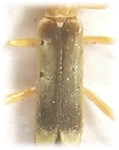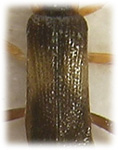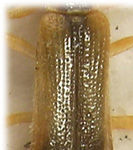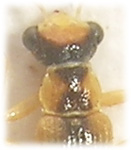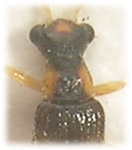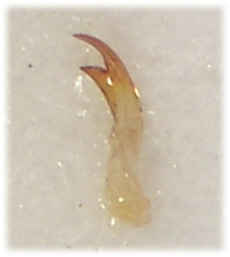
Fig.1
Malthinus consists of only four species in Britain and can be separated by the following key.
M.frontalis (Marsham, 1802)
3-3.5mm. Easily separated from the other Malthinus spp. by the unicolorous black upper surface although the male has a yellow forehead (Fowler, 1887) and the legs are reddish in both sexes. In the male the antennae are much longer than the female. Care should be taken to eaxamine the mandibular tooth as this species can be confused with the darker Malthodes spp.
Fowler states they can be recorded by beating fir trees although Alexander (2003) states 'it appears to be associated with large, old, native broadleaved trees'.
M.flaveolus (Paykull, 1799)
4.5-5.5mm. The largest of the genus and with the yellow forehead, scutellum and legs could, in the field, be confused for a large M.seriepunctatus however the all orange pronotum and the obscurely punctured elytral striae will serve to separate this species.
M.seriepunctatus Kiesenwetter, 1852
3-3.5mm. Head black with forehead yellow. Thorax orange with a central black mark extended the entire length sometimes contracted centrally. Scutellum variously yellow. Elytra light grey darkening towards the bright yellow apical spots. Legs yellow in both sexes.
M.balteatus Suffrian, 1851
Head black with a small orange spot between antennal insertions. Thorax as M.seriepunctatus but with the black mark sinuate laterally or gentley constricted rather than 'hourglass'. Elytra darker with a transverse band of grey about middle. Scutellum dark. Hind legs fuscous although Fitton (1973) suggests this is only so in the female.
References
Fowler, 1887. The Coleoptera of the British Isles L.Reeve and Co
Alexander, K.N.A. 2003. Provisional atlas of the Cantharoidea and Buprestoidea of Britain and Ireland. BRC



